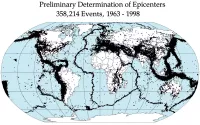Thailand, formerly known as Siam, is a Southeast Asian country bordering Myanmar, Laos, Cambodia, and Malaysia. It has maritime boundaries with Vietnam, Indonesia, and India. Its capital and largest city is Bangkok. The country has a population of approximately 66 million people and covers an area of about 513,115 km2.
1905: Unsuccessful rebellions
In 1905, there were unsuccessful rebellions in the ancient Patani area, Ubon Ratchathani, and Phrae against attempts to blunt the power of local lords.
1909: First Census
In 1909, Thailand's first census found the population to be 8.2 million.
1910: Reign of Vajiravudh begins
In 1910, Vajiravudh began his reign and responded to the Palace Revolt by promoting the idea of the Thai nation.
1910: Reign of Chulalongkorn ends
In 1910, the reign of King Chulalongkorn ended.
1912: Palace Revolt
In 1912, the Palace Revolt was a failed attempt by Western-educated military officers to overthrow the Siamese monarchy.
1925: End of Vajiravudh's reign
Vajiravudh's reign ended in 1925.
June 1932: Bloodless Revolution
On June 24, 1932, the Khana Ratsadon (People's Party) carried out a bloodless revolution in Thailand, marking the beginning of constitutional monarchy.
1932: King intervenes
Following mass killings of protestors in October 1973, King Adulyadej installed Sanya Dharmasakti as Prime Minister, marking the first time that the king had intervened in Thai politics directly since 1932.
1932: Siamese Revolution
In 1932, the Siamese revolution led by the Khana Ratsadon transitioned Siam from an absolute monarchy to a parliamentary constitutional monarchy, and it was officially renamed Thailand.
1933: Counter-revolutionary rebellion
In 1933, Prime Minister Phraya Mano led a counter-revolutionary rebellion to reinstate an absolute monarchy under Prajadhipok, followed by a military coup.
1938: Plaek Phibunsongkhram becomes premier
In 1938, Plaek Phibunsongkhram became premier and launched a campaign of political repression.
June 1939: Name change to Thailand
On June 24th, 1939, Siam was officially changed to Thailand.
1939: Siam changed to Thailand
In 1939, Phibun changed the country's name from "Siam" to "Thailand" and imposed twelve Thai cultural mandates.
1939: Thailand formerly known as Siam
Prior to 1939, Thailand was known to outsiders as Siam.
October 1940: Invasion of French Indochinese territories
In October 1940, Phibun launched an opportunistic invasion of French Indochinese territories, resulting in Thailand gaining some Lao and Cambodian territories.
December 1941: Japanese invasion of Thailand
On December 8, 1941, the Japanese Empire launched an invasion of Thailand. On December 21st, Thailand and Japan signed a military alliance.
1945: End of World War II
After World War II ended in 1945, Phibun was ousted, and Thailand signed formal agreements to end the state of war with the Allies.
June 1946: Death of King Ananda
In June 1946, King Ananda was found dead under mysterious circumstances, and his younger brother Bhumibol Adulyadej ascended to the throne.
1946: Military and Bureaucratic Control
Between 1946 and the 1980s, military and bureaucratic aristocrats fully controlled political parties in Thailand.
1947: Phibun takes power
In 1947, Phibun launched another military coup to take power.
1954: Establishment of SEATO
In 1954, Thailand helped to establish the US-aligned Southeast Asia Treaty Organization (SEATO).
1955: Phibun begins to democratize Thai politics
Following a tour of Europe and the US in 1955, Phibun began to democratize Thai politics.
December 1956: Opening of Lumpinee Boxing Stadium
In December 1956, the Lumpinee Boxing Stadium first opened at Rama IV Road near Lumphini Park.
1957: Sarit Thanarat takes power
In 1957, Field Marshal Sarit Thanarat took power by coup.
1957: Ouster of Phibun
In 1957, the US supported the final ouster of Phibun.
1959: Autocratic rule of Sarit Thanarat
From 1959 to 1963, Sarit Thanarat's rule was autocratic.
1960: Population Growth Rate
In 1960, Thailand's population growth rate was 3.1%.
1961: Thailand militarily supports the US invasion of Vietnam
In 1961, Thailand militarily supported the United States invasion of Vietnam.
1962: Agricultural sector Growth
Between 1962 and 1983, the agricultural sector grew by 4.1% per year on average and continued to grow at 2.2% between 1983 and 2007.
1963: End of Sarit Thanarat's rule
In 1963, the rule of Sarit Thanarat ended.
1966: Thailand Wins Silver at Asian Games
In 1966, the Thailand national basketball team won the silver medal at the Asian Games, marking their most successful year.
1970: Average Household Size
In 1970, an average of 5.7 people lived in a Thai household.
1972: Thailand in AFC Asian Cup Semifinals
In 1972, the Thailand national football team reached the semifinals of the AFC Asian Cup, which was hosted in Thailand.
October 1973: Democratic uprising
In October 1973, a popular democratic uprising began against the Thanom government.
October 1976: Thammasat University massacre
In October 1976, the Thammasat University massacre occurred, followed by a military coup that brought Thailand a new ultra-right wing military government.
1976: Coup d'état
In 1976, a coup d'état occurred in Thailand.
1978: Amnesty for communist fighters
In 1978, a more moderate military government offered amnesty to some communist fighters.
1980: Agriculture Employment
In 1980, 70% of Thailand's labor force was employed in agriculture.
1980: Prem Tinsulanonda appointed Prime Minister
In 1980, Military figure Prem Tinsulanonda was appointed Prime Minister.
1981: Military coup attempt against Prem
In 1981, there was a foiled military coup attempt against Prem.
1983: End to the Communist insurgency
By 1983, there was a negotiated end to the Communist insurgency.
1985: Military coup attempt against Prem
In 1985, there was another foiled military coup attempt against Prem.
1988: First Freely-Elected Prime Minister Since 1976
In 1988, Thailand had its first freely-elected prime minister since the 1976 coup, with Chatichai Choonhavan assuming the role.
1989: Ban on Elephants for Logging
In 1989, the government of Thailand banned the use of elephants for logging, leading many elephant owners to move their domesticated animals to the tourism industry.
1990: Urban Population Statistics
In the 1990 census, 29.4% of Thailand's population lived in urban areas.
1991: National Government Organisation Act
In 1991, Thailand divided the administrative services of the executive branch into three levels by the National Government Organisation Act, BE 2534: central, provincial, and local.
March 1992: General Election and Popular Demonstration
In March 1992, a general election in Thailand led to Suchinda Kraprayoon being nominated as prime minister, triggering a popular demonstration in Bangkok that ended in a bloody military crackdown, an event known as Black May.
September 1992: Free Elections and Democrat Party Ascendancy
In September 1992, free elections were held once again in Thailand, bringing the neoliberal Democrat Party to power.
1992: Two-Party System
Between 1992 and 2006, Thailand had a two-party system.
September 1994: Mass Rapid Transit Master Plan Endorsement
On September 27, 1994, the Mass Rapid Transit Master Plan in Bangkok Metropolitan Region was endorsed by the cabinet.
1995: Education Reform Plans
In 1995, Sukavich Rangsitpollaid, as minister of education, announced plans for educational reform in Thailand.
1995: Mass Rapid Transit Implementation
In 1995, the Mass Rapid Transit Master Plan began implementation in Bangkok Metropolitan Region.
1997: Ethnic Community Data
Around 1997, Lao people numbered 15,080,000, Khon Muang numbered six million, and Pak Tai numbered 4.5 million.
1997: Central Thai Population
In 1997, approximately 20,650,000 Central Thai made up 34.1 per cent of the state's population of 60,544,937.
1997: Asian Financial Crisis
In 1997, the Thai government's attempt to peg the Thai baht to the US dollar induced the Asian financial crisis, ending 40 years of economic growth.
1997: "People's Constitution" Drafting
Throughout the 1990s, various neoliberal parties had a hand in drafting the 1997 "People's Constitution," which acknowledged human rights and established accountability measures.
1998: Thammasat Stadium Built for Asian Games
Thammasat Stadium in Bangkok was built for the 1998 Asian Games.
1999: International Degree Students Statistics
Between 1999 and 2012, the number of international degree students in Thailand increased by 9.7 times.
2000: Evidence of rice growing
Around 2000 BCE, the earliest evidence of rice growing in present-day Thailand has been dated.
2000: Urban Population Statistics
In the 2000 census, 31.1% of Thailand's population lived in urban areas.
2001: Thaksin Shinawatra's Governorship
From 2001 until 2006, Thaksin Shinawatra of the Thai Rak Thai party governed as prime minister in Thailand, implementing policies to reduce rural poverty and provide universal healthcare.
2001: Thaksin Shinawatra becomes Prime Minister
In 2001, Thaksin Shinawatra became the Prime Minister of Thailand, beginning a period of political conflict.
2002: Hospital Accreditation
In 2002, Bumrungrad became the first hospital in Asia to meet the Joint Commission International standard.
2003: Repayment of IMF Loan
In 2003, Thailand repaid the $17 billion International Monetary Fund loan taken out to cover a shortage of foreign currency and investments.
2003: Ong-Bak: Muay Thai Warrior Film Release
In 2003, the film "Ong-Bak: Muay Thai Warrior" starring Tony Jaa, was released.
September 2004: Withdrawal from Iraq
In September 2004, Thailand withdrew its humanitarian contingent from Iraq, having joined the US-led invasion.
2004: South Thailand Insurgency and Indian Ocean Tsunami
In 2004, Thailand faced the escalating South Thailand insurgency and the Indian Ocean earthquake and tsunami, which claimed around 8,000 lives in Thailand.
2004: Shutter Film Recognition
In 2004, the Thai horror movie "Shutter" was recognized worldwide.
2005: Thailand Hosts International Rugby Tournament
In 2005, Thailand became the first country to host an international 80 welterweight rugby tournament.
2005: Controversies Surrounding Institutions
In 2005, the crisis surrounding Thaksin peaked with a series of controversies surrounding Buddhist and monarchic institutions.
2005: Tom-Yum-Goong Film Release
In 2005, the film "Tom-Yum-Goong", starring Tony Jaa, was released, featuring distinctive aspects of Thai martial arts.
2006: Two-Party System Ends
Between 1992 and 2006, Thailand had a two-party system.
2006: End of Thaksin Shinawatra's Governorship
From 2001 until 2006, Thaksin Shinawatra of the Thai Rak Thai party governed as prime minister in Thailand. 2006 marked the end of his rule.
2006: Coup d'état and Dissolution of Thaksin's Party
In 2006, a coup d'état led by the army dissolved Thaksin's party and banned over a hundred of its executives from politics, installing a military government for one year.
2006: Coup d'état
In 2006, a coup d'état occurred in Thailand amid political conflict between supporters and opponents of Prime Minister Thaksin Shinawatra.
2007: Election of Civilian Government
In 2007, a civilian government led by the Thaksin-aligned People's Power Party (PPP) was elected in Thailand.
2008: Cambodian-Thai border crisis
In 2008, the Cambodian-Thai border crisis began, involving territorial disputes and military clashes.
2008: Non-National Residents
In 2008, the number of non-national residents in Thailand was an estimated 2 million.
April 2009: Cambodian–Thai border crisis
In April 2009, the Cambodian–Thai border crisis escalated, leading to troop deployments near the Preah Vihear Hindu temple.
2009: Military Led Years
"Uniformed or ex-military men have led Thailand for 55 of the 83 years" between 1932 and 2009.
2009: Non-National Residents
As of 2009, the total number of non-national residents in Thailand was around 3.5 million.
2009: Pro-Thaksin Protests
In 2009, the pro-Thaksin United Front for Democracy Against Dictatorship (UDD) protested in Thailand.
2009: National Health Expenditures
In 2009, total national expenditures on health in Thailand amounted to 4.3 per cent of GDP.
2010: Population Composition
As of 2010, Thai people made up 95.9% of Thailand's population.
2010: Urban Population
As of 2010, about 44.2% of Thailand's population lived in urban areas.
2010: Violent Military Crackdown on Protests
In 2010, protests by the pro-Thaksin United Front for Democracy Against Dictatorship (UDD) ended with a violent military crackdown, causing more than 70 civilian deaths in Thailand.
2011: Ethnic Communities Recognition
According to the Royal Thai Government's 2011 Country Report, 62 ethnic communities are officially recognised in Thailand.
2011: Journal Publications Increase
Between 2011 and 2016, Thailand's journal publications increased by 20%.
2011: Thailand Country Report Publication
In 2011, Thailand published the Thailand Country Report providing population numbers for mountain peoples and ethnic communities.
2011: Cambodian-Thai border crisis
In 2011, the Cambodian-Thai border crisis continued, involving territorial disputes and military clashes.
2011: Chang Thailand Slammers Win Championship
In 2011, the Chang Thailand Slammers won the ASEAN Basketball League Championship.
2011: Entertainment Industries Contribution to GDP
In 2011, the entertainment industries directly contributed $2.1 billion in GDP to the Thai economy and directly supported 86,600 jobs.
2011: Pheu Thai Party Victory and Yingluck Shinawatra's Premiership
In 2011, the populist Pheu Thai Party won a majority in the general election, and Yingluck Shinawatra became prime minister of Thailand.
2012: Airport Statistics
As of 2012, Thailand had 103 airports with 63 paved runways, with Bangkok's Suvarnabhumi Airport being the busiest.
2012: Thailand's pick-up trucks consumption
As of 2012, Thailand was the second largest consumer of pick-up trucks in the world, after the US, due to its favorable taxation.
2012: Automotive Industry Ranking
As of 2012, the Thai automotive industry was the largest in Southeast Asia and the 9th largest in the world.
2012: Informal Labour Vulnerabilities
In 2012, a study found that 64% of informal workers in Thailand had not completed education beyond primary school, increasing their vulnerability to exploitation and human trafficking. Many informal workers are migrants without legal status, and the sector is not recognized under the Labour Protection Act.
2012: Informal Workers
In 2012, it was estimated that informal workers comprised 62.6% of the Thai workforce.
2012: International Degree Students Statistics
In 2012, there were 20,309 international students.
2013: Thailand most visited country in Southeast Asia
In 2013, Thailand was the most visited country in Southeast Asia, according to the World Tourism Organisation.
2013: High-Speed Internet Access for Schools
In 2013, the Ministry of Information and Communication Technology announced that 27,231 schools would receive classroom-level access to high-speed internet.
February 2014: Lumpinee Boxing Stadium Hosts Final Matches at Original Site
On 8 February 2014, the Lumpinee Boxing Stadium hosted its final Muay Thai boxing matches at its original site on Rama IV Road near Lumphini Park.
2014: Highest Number of Lèse-majesté Prisoners
After the coup d'état in 2014, Thailand had the highest number of lèse-majesté prisoners in the nation's history.
2014: Military Coup
Between 2014 and 2019, the military junta self-titled as the National Council for Peace and Order ruled the country.
2014: Increased Chinese influence after 2014 coup
Following the 2014 coup, Thailand shifted closer to China, leading to concerns about economic dependence and influence.
2014: Electrical Generation Sources
In 2014, 75% of Thailand's electrical generation was powered by natural gas.
2014: Income Inequality Report
In 2014, Credit Suisse reported that Thailand was the world's third most unequal country, with the top 10% richest holding 79% of the country's assets.
2014: Coup d'état
In 2014, another coup d'état occurred in Thailand, ending the crisis that had followed the proposal of an amnesty bill.
2014: Pick-up trucks sales
In 2014, pick-up trucks accounted for 42% of all new vehicle sales in Thailand.
2014: Unemployment Rate
In the third quarter of 2014, the unemployment rate in Thailand stood at 0.84% according to Thailand's National Economic and Social Development Board (NESDB).
September 2015: Military Strength Index Ranking
In September 2015, Thailand ranked 16th worldwide in the Military Strength Index according to a Credit Suisse report.
2015: Youth Literacy Rate
In 2015, Thailand's youth literacy rate was 98.1%.
October 2016: Reign of Vajiralongkorn
Since October 2016, Vajiralongkorn (Rama X) has reigned as the King of Thailand.
2016: Journal Publications Increase
Between 2011 and 2016, Thailand's journal publications increased by 20%.
2016: Poverty Statistics
In 2016, 5.81 million people lived in poverty in Thailand, or 11.6 million including the "near poor".
2016: Death of King Bhumibol and Ascension of Vajiralongkorn
In 2016, Bhumibol, the longest-reigning Thai king, died, and his son Vajiralongkorn ascended to the throne.
2016: Biocapacity Deficit
In 2016, Thailand had a biocapacity deficit, using twice as much biocapacity as it contained.
2016: Environmental Performance Index Ranking
In 2016, Thailand's Environmental Performance Index (EPI) ranking was 91 out of 180 countries.
2016: Wealth per Adult Person
In 2016, Thais had median wealth per adult person of $1,469, increasing from $605 in 2010.
2017: Highway Statistics
As of 2017, Thailand has over 462,133 roads and 37 million registered vehicles, with 20 million motorbikes.
2017: Thailand operates under the 2017 Constitution
In 2017, Thailand began operating under its current constitution.
2017: Thailand GDP
In 2017, Thailand's GDP was US$1.236 trillion on a purchasing power parity basis, making it the second largest economy in Southeast Asia.
2017: Median Household Income
In 2017, Thailand's median household income was ฿26,946 per month, with income disparity between top and bottom quintiles.
2017: Economic Growth
In 2017, the Thai economy grew by 3.9%, marking its fastest expansion since 2012.
2017: Bad Genius Film Success
In 2017, the Thai heist thriller film "Bad Genius" achieved international success, winning awards and earning over $42 million worldwide.
2017: Current Constitution
Thailand's latest and current constitution was established in 2017.
December 2018: Legalisation of Medical Cannabis
In December 2018, Thailand legalised the use of cannabis for medical reasons, making it the first Southeast Asian country to do so.
2018: Religious Demographics
According to the 2018 National Statistical Office data, 93.46% of Thailand's population self-identified as Buddhists.
2018: Taxi Registrations
As of 2018, Thailand had over 80,647 registered taxis nationwide.
2018: Alternative Energy Development Plan
In 2018, the Thai government developed the Alternative Energy Development Plan 2018–2037 (AEDP 2018).
2018: Medical Tourism Ranking
Thailand ranks as the worlds fifth largest medical tourism destination in spending, attracting over 2.5 million visitors in 2018, and is number one in Asia.
2019: End of military rule
Between 2014 and 2019, the military junta self-titled as the National Council for Peace and Order ruled the country. Its rule ended in 2019.
2019: Research and Development Investment
In 2019, Thailand devoted 1.1% of its GDP to research and development of science, with over 166,788 research and development personnel.
2019: Forest Landscape Integrity Index Score
In 2019, Thailand had a Forest Landscape Integrity Index mean score of 6.00/10, ranking it 88th globally out of 172 countries.
2019: Thai general election
In 2019, Thailand held a general election which led to a coalition government.
2019: General Election and Pro-Democracy Protests
In 2019, Thailand held a general election, and Prayut Chan-o-cha continued his premiership amid allegations of election fraud, triggering pro-democracy protests.
2019: Global Health Security Index Ranking
In 2019, Thailand ranked sixth in the world and first in Asia in the Global Health Security Index.
2019: Tourism Statistics
In 2019, Thailand received 39.8 million international tourists and was the fourth highest in international tourism earning 60.5 billion US dollars.
2019: End of National Council for Peace and Order Rule
In 2019, the National Council for Peace and Order, a military junta, ended its rule in Thailand.
March 2020: Amnesty International Report on Military Conscripts
In March 2020, Amnesty International released a report alleging that Thai military conscripts face institutionalized abuse systematically hushed up by military authorities.
2020: English Proficiency Ranking
As of 2020, Thailand was ranked 89th out of 100 countries globally for English proficiency.
2020: Dissolution of Future Forward Party
In 2020, the Future Forward party was dissolved, an example of how an "alliance of conservative forces in Thailand—including monarchists, the army and a handful of business tycoons—has sought to suppress opposition".
2022: Export and Import
In 2022, Thailand's export of goods was worth approximately US$290 billion, while its import was worth approximately US$305 billion.
2022: Oil and Gas Production Decrease
In 2022, Thailand's oil and gas production dropped by 19% and 17%, respectively.
2022: Average Household Size
In 2022, the average Thai household size was 3 people.
May 2023: Opposition Victory in General Election
In May 2023, Thailand's reformist opposition, including the Move Forward Party and Pheu Thai Party, won the general election, ending 9 years of royalist-military rule.
August 2023: Srettha Thavisin Becomes Prime Minister and Thaksin's Return
On 22 August 2023, Srettha Thavisin of the Pheu Thai party became Thailand's new prime minister, and Thaksin Shinawatra returned to Thailand after years in self-imposed exile.
2023: Thailand's Stance on Israel-Gaza War
In 2023, during the Israel-Gaza war, Thailand initially condemned the attack against Israel but later adopted a neutral stance. 28 Thai nationals were killed in this conflict.
2023: Victors of the 2023 Elections
On August 7, 2024, Thailand's Constitutional Court banned the victors of the 2023 parliamentary elections, the Move Forward Party and all of its leaders from politics for proposing lèse-majesté law reforms.
August 7, 2024: Move Forward Party Banned
On August 7, 2024, Thailand's Constitutional Court banned the Move Forward Party and its leaders from politics for proposing lèse-majesté law reforms.
August 2024: Srettha Thavisin's Dismissal as Prime Minister
On 14 August 2024, Srettha Thavisin was dismissed from his prime ministerial role by the Constitutional Court for "gross ethics violations" in Thailand.
2024: Economic Challenges
As of 2024, Thailand faces challenges including low productivity, poor education, high household debt, low private investment, and slow economic growth.
2024: Global Innovation Index Ranking
In 2024, Thailand ranked 41st in the Global Innovation Index.
2024: Fertility Rate Decline
In 2024, Thailand's total fertility rate declined to 1.0, ranking it among countries with ultra-low fertility rates.
2024: Improved Status on Freedom House Index
In the Freedom in the World 2024 Report, Thailand's status improved from not free to partly free due to competitive parliamentary elections and the formation of a new governing coalition, though unelected senators ensured that the party with the most votes was excluded.
Jan 2025: Population Statistics
On January 8, 2025, Thailand had a population of 65.95 million.
September 2025: Arrest Order for Thaksin
In September 2025, the Constitutional Court ordered the arrest of Thaksin in Thailand.
2025: State Railway of Thailand Track Length
As of 2025, the State Railway of Thailand (SRT) had 4,507 km of meter gauge track, mostly single-track, with some double or triple-tracked sections around Bangkok.
2025: Cambodia-Thailand border crisis
In 2025, the Cambodia-Thailand border crisis continues, involving territorial disputes and military clashes.
2037: Renewable Energy Goals
The Alternative Energy Development Plan 2018–2037 (AEDP 2018) defines goals for the increase of renewable energy to almost 30,000 MW by 2037.
Mentioned in this timeline

Basketball is a team sport played on a rectangular court...
India officially the Republic of India is a South Asian...
CNN Cable News Network is a multinational news organization founded...
Myanmar also known as Burma is a Southeast Asian country...
The Association of Southeast Asian Nations ASEAN is a regional...
Germany officially the Federal Republic of Germany is a Western...
Trending

8 months ago Davante Adams expresses optimism about Rams, refused talks with 49ers over offer.
2 months ago Chuba Hubbard Injury Update: Doubtful for Week 5 Due to Injury
6 months ago Nate Burleson Launches LionBlood Vodka with Valentine Distilling; Gayle King's Outfit Choice

14 days ago Earthquake Rattles Northern California on Thanksgiving: Santa Rosa Area Sees 3.3 Magnitude

Bo Nix is an American football quarterback currently playing for the Denver Broncos in the NFL After three seasons with...

7 months ago Chris Olave Trade Rumors Surface Amidst Derek Carr's Retirement and Eagles Interest
Popular

Candace Owens is an American conservative political commentator and author...

Ilhan Omar is an American politician currently serving as the...

XXXTentacion born Jahseh Dwayne Ricardo Onfroy was a controversial yet...

Tom Cotton is an American politician and Army veteran currently...

Kelsey Grammer is an accomplished American actor producer and singer...

Oprah Winfrey an American talk show host television producer actress...